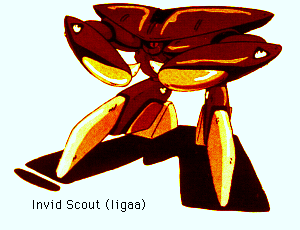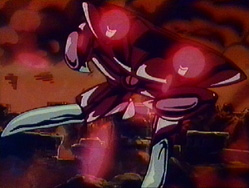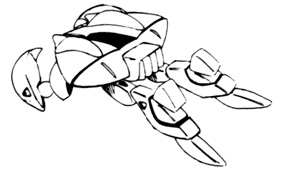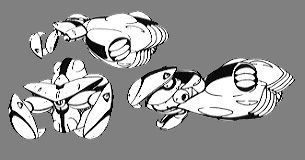 by Pieter Thomassen, with Peter Walker and Robert Morgenstern
by Pieter Thomassen, with Peter Walker and Robert Morgenstern
| | | | | |
Iigaa Light General-Purpose Aerospace Mecha.
|

|

|

|
 |
 |  |  |  |  |  |
I. Dimensions:
| Height: | 2.51 m (without gun pods) |
| 2.73 m (with gun pods) |
| Depth: | 3.25 m |
| Breadth: | 3.75 m |
| Weight | 4.5 metric tons |
II. Type:
- Single seat all-weather ground, (aero)space combat mecha. Note that the cockpit is too small to accommodate larger Invid.
III. Service History
- The service entry date is unknown. The earliest confirmed recording of an Iigaa mecha was taken in 2023 during the invasion of Tirol. At that juncture the Iigaa was already in service in large numbers.
- Presumably, the Iigaa remains in service with the Regess' faction of the Invid.
IV. Propulsion:
- Main engine: one IE-2 vectorable plasma-shock expansion thruster in the rear, with a power output of 71 kN.
- Attitude control: several internal gyroscopes for attitude control.
- Powerplant: one protoculture cell energizer.
- Fuel capacity: 6 standard cannisters of protoculture.
V. Performance:
VI. Electronics:
- One IMSC-1VS visual/LLLTV sensor cluster in the center of the front plate. The spectral resolution of this sensor is very poor.
- One IMSC-1RS variable frequency multi-mode phased array spherical radar system with main antennas in the arms and forward edges of the main body, and secondary antennas in the legs and rear. The radar system is advanced even by contemporary Terran standards and offers a full set of ranging, search, track, mapping and observation modes, including a high-resolution ISAR option. The installation can also function in a passive ESM mode.
- (post 2042 mecha on Earth only): One IMSC-1PS Protoculture sensor, providing detection and tracking of active protoculture-powered mecha. For detection of a high-power Veritech fighter, good resolution extends out to 3 km, fair resolution out to 6 km, and poor resolution out to 16.8 km. A typical Destroid is detectable at slightly more than half these distances, a Cyclone at four percent of these distances, and a Gallant rifle at about one percent of these distances. Mecha in service on Earth from around 2035 to 2040 operated equivalently at about twenty-five percent of the above ranges.
VII. Armament:
- Two armor-piercing pincers are located at the tip of the arms of the mecha.
- Two hardpoints for gunpods are mounted on top of the mecha. Both hardpoints
always mount identical gunpods and fire in parallel. The following gunpods have
been observed:
- ILG-1 plasma beam cannon (first observed 2023). This pod stores plasma and discharges it in a continuous beam. Typically, a one-second burst contains 2.5 MJ of thermal and kinetic energy. The ILG-1 can store sufficient plasma for 20 seconds of continuous fire.
- ILG-2 plasma pulse cannon (first observed 2023). This pod stores plasma and discharges it in discrete packages ('annihilation discs'). Typically, a one-second burst from a single cannon contains 2.6 MJ of thermal and kinetic energy. The ILG-2 can store sufficient plasma for 20 seconds of continuous fire.
- ILG-3 plasma pulse cannon (first observed 2041). This pod stores plasma and discharges it in discrete packages ('annihilation discs'). Typically, a one-second burst from a single cannon contains 3.0 MJ of thermal and kinetic energy. The ILG-3 can store sufficient plasma for 25 seconds of continuous fire.
VIII. Armor:
The armor of the Iigaa is composed of a composite of metals, ceramics, and organics unique to Invid manufacture. Research continues into the composition of this material, though results from X-ray crystallography, NMR, and mass spectroscopy studies remain classified. The armor stops all small arms fire, provides good protection against heavier infantry weapons, such as a 12.7 mm machinegun round, and fair resistance to light mecha-mounted weaponry, such as the Zentraedi 22.3 mm HE autocannon round.
Note: The IMSC-1 sensor eye is highly susceptible to damage, and any hit on it will disable the mecha and likely penetrate the cockpit and kill the pilot.
All Invid mecha provide full protection from nuclear, biological, and chemical hazards, using a sealed cockpit environment.
IX. Development:

The Iigaa mecha is the smallest Invid mecha currently in service save for the Malar power armor. It is a design that reminds most Terrans of a crab, with a triangular, low body, and prominent arms and legs. The arms end in pinchers, while the feet resemble claws. A single, vectorable thruster is located in the back.
In the Invid forces in the Tirolian regions and the Regess' forces on Earth, the Iigaa performed the functions of fighter, assault plane, and reconnaissance craft. In addition, many Iigaa were used as suicide ramming craft against naval fleet formations.
The Iigaa are small, and well suited to mass production. This serves the Invid swarming tactics well, although the respective kill rates against Terran or Tirolian mecha are very lob-sided in favor of the Terragen designs. The reasons for this lay partly in the weapons design, which was less suited for aerial warfare, partly in low resistance to the standard weapons as mounted on the Terragen designs, and in the lack of any form of active electronic warfare system. Invid pilot training was also markedly inferior to human standards.
Regardless of this, however, the Iigaa remains an effective scout against protoculture-fueled opponents, with high mobility and a low emission signature. As a suicide craft the Iigaa lacks in penetrating power and destructive capability, but the numbers have so far always tended to make up any deficiencies, as evidenced by the defeats of the REF flotillas over Earth.
See additional design notes.
Return to Invid Mecha index.
I. Dimensions.
- Height:
| 2.40 m |
- Length:
| 4.45 m |
- Breadth:
| 3.75 m |
- Weight:
| 3.5 metric tons. |
II. Type:
- Attachable space mobility/booster unit for the Iigaa mecha.
III. Service History
- Service entry date unknown. The booster unit was first observed in 2031.
- Presumably, the Iigaa remains in service with the Regess' faction of the Invid.
IV. Propulsion:
- Main engine: one IE-1 quadruple vectorable plasma-shock expansion thruster in the rear, with a power output of 106 kN.
- Attitude control: several internal gyroscopes for attitude control.
- Powerplant: one protoculture cell energizer.
- Fuel capacity: 4 standard cannisters of protoculture.
V. Performance:
- Maximum acceleration 1.3 g.
- Estimated protoculture cell endurance: around 80 hours of operational use.
- Delta-v capacity: 4.2 kps.
VI. Electronics:
- IMSC-1BS long range phased array radar system in the main hull of the booster. This radar operates in conjunction with the IMSC-1RS standard fitted to the Iigaa, and provides long wavelength, long distance search and track functions.
- The IMSC-1RS has access to additional secondary antennas on the main booster body, replacing the displaced arrays that are mounted on the removed legs, providing medium to short range coverage of the aft hemisphere.
- The standard Iigaa sensors can also function while the mecha is fitted to the booster. Additional protoculture sensors in the booster unit offset the loss of the leg mounted sensors, and though the number of sensors for the boosted Iigaa and the standard model remains the same, the vacuum conditions, large protoculture radiation output of naval vessels and unrestricted lines of sight lead to a substantial increase in detection ranges.
VII. Armor:
The armor of the Iigaa booster unit is composed of a composite of metals, ceramics, and organics unique to Invid manufacture. Research continues into the composition of this material, though results from X-ray crystallography, NMR, and mass spectroscopy studies remain classified. The armor stops all small arms fire, provides good protection against heavier infantry weapons, such as a 12.7 mm machinegun round, and fair resistance to light mecha-mounted weaponry, such as the Zentraedi 22.3 mm HE autocannon round.
VIII. Development:
This booster unit, connected to an Iigaa that has had its legs removed, turns the mecha into a maneuverable space fighter. The booster-equipped Iigaa usually launch from Mollusk Troop Carriers.
The booster turns a standard Iigaa body and arm section into a fast space fighter. This mecha is often used with an unarmed Iigaa however, and then serves as a kamikaze ramming ship against naval vessels, a role in which it achieved unexpected good results -- if one overlooks the loss of the mecha and the pilot in the first mission.
It has been speculated that the booster was developed and put in service in such large numbers because the Invid lacked true warships over Earth, and were therefore forced to resort to these kind of desperation tactics. If true, then the boosters must have been a stopgap solution at least in the anti-ship role. It is not known if the Invid planned to keep deploying these mecha after they had constructed warships, but it is certain that the Terrestrial Invid have discontinued the use of the booster-Iigaa, likely because as humaniform Invid with relatively small numbers they are adverse to suicide tactics. Also, a human pilot does not fit into the cockpit unless he or she is of less than average size.
Return to Invid Mecha index.
Go to Robotech Reference Guide Home Page.
Robotech (R) is the property of Harmony Gold. This document is in no
way intended to infringe upon their rights.
Content by Pieter Thomassen, with Peter Walker and Rob Morgenstern
HTML by Robert Morgenstern (rmorgens@ieee.org)
Copyright © 2000, 1997, 1995 Robert Morgenstern, Pieter Thomassen, Peter Walker






